Unit 3 REACHING OUT ACROSS THE SEA Reading and Thinking Reaching Out Across the Sea教学设计
文档属性
| 名称 | Unit 3 REACHING OUT ACROSS THE SEA Reading and Thinking Reaching Out Across the Sea教学设计 | 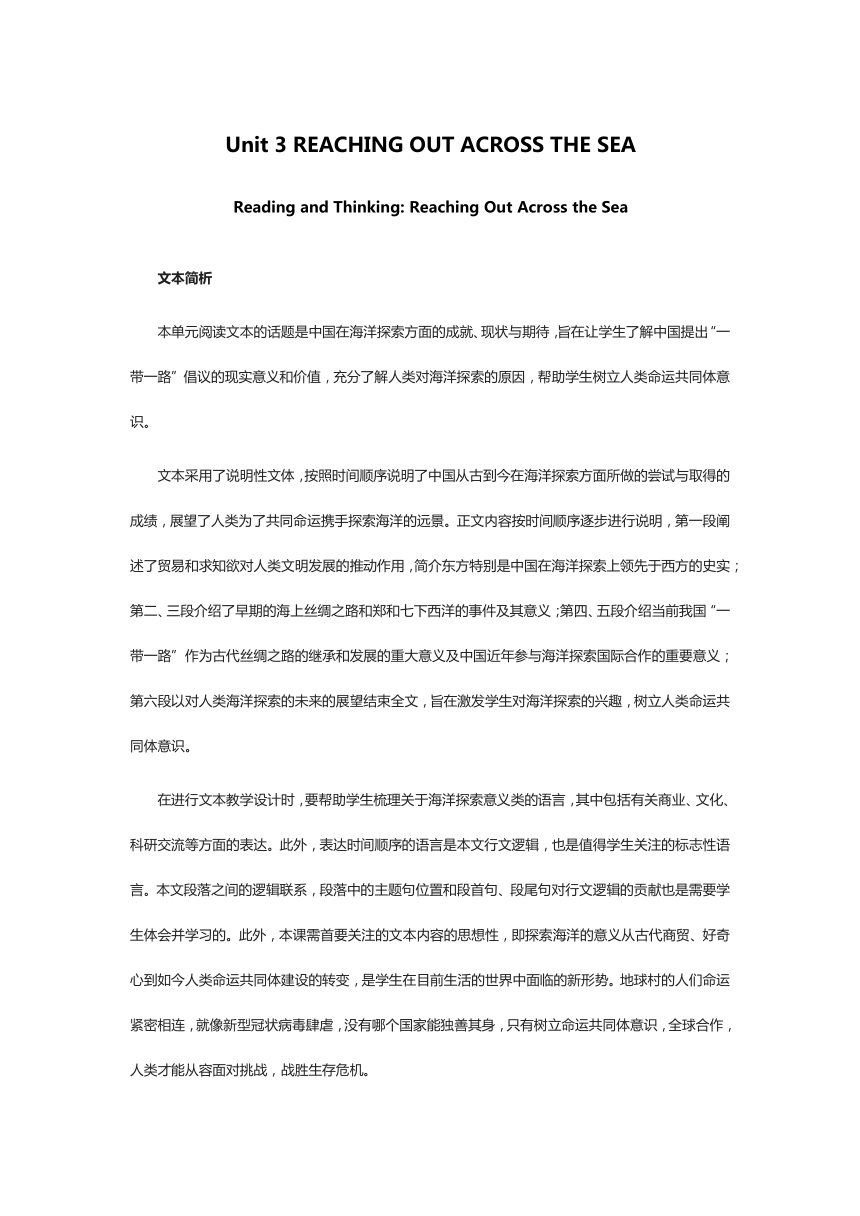 | |
| 格式 | zip | ||
| 文件大小 | 92.8KB | ||
| 资源类型 | 教案 | ||
| 版本资源 | 人教版(2019) | ||
| 科目 | 英语 | ||
| 更新时间 | 2022-06-11 12:47:55 | ||
图片预览

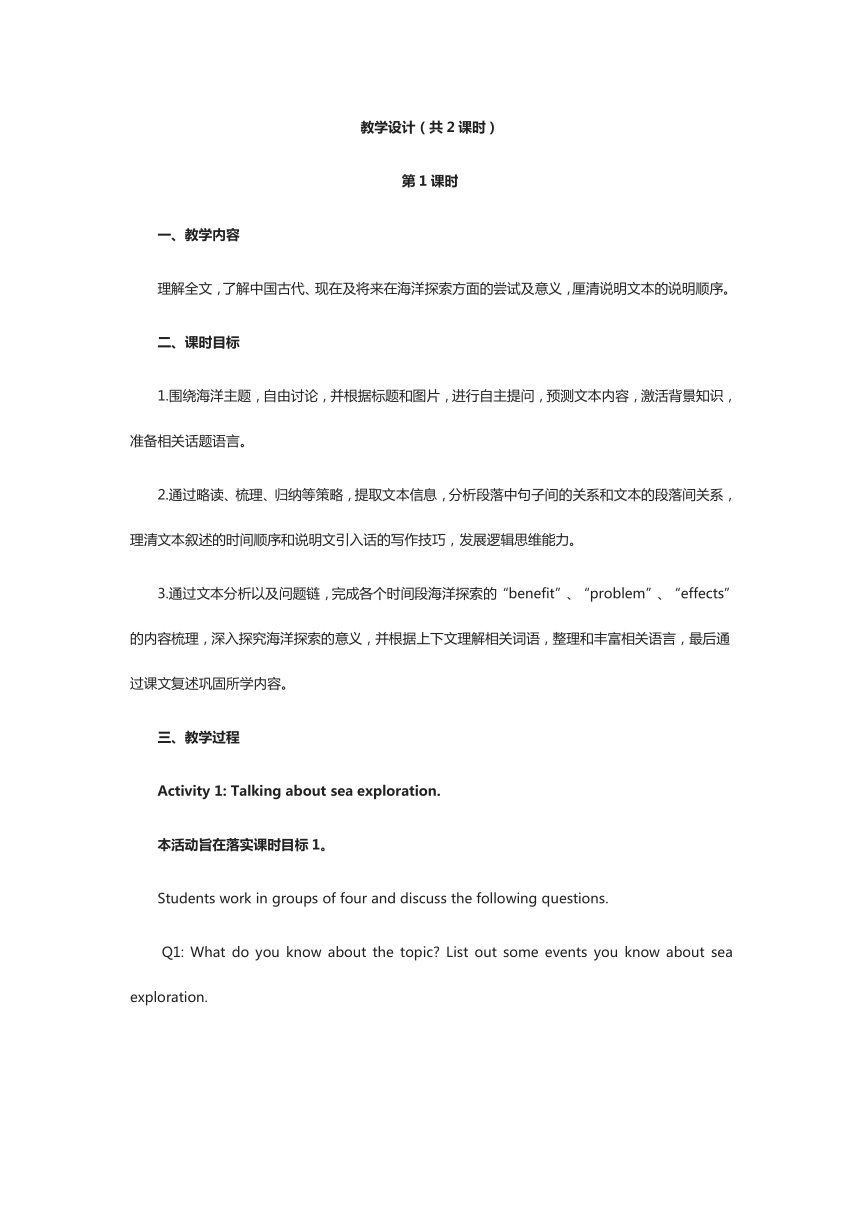
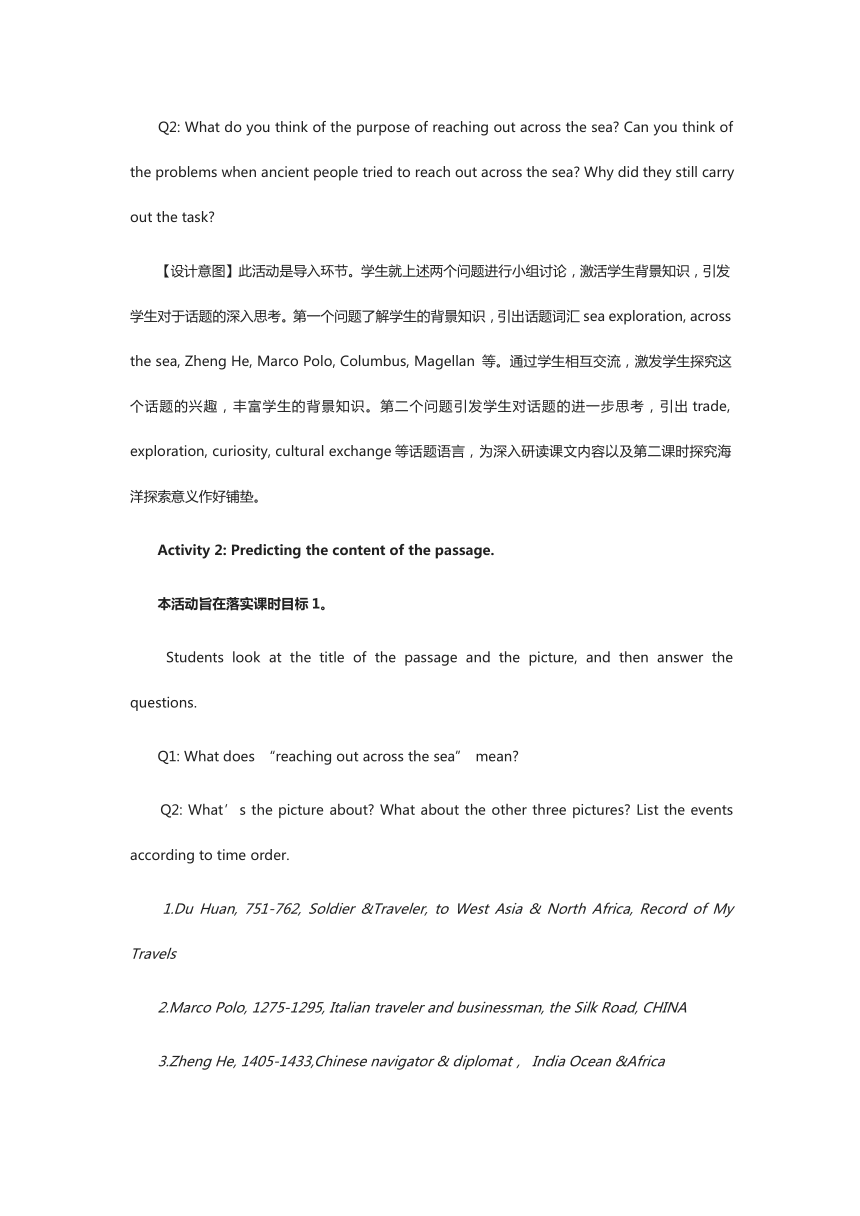
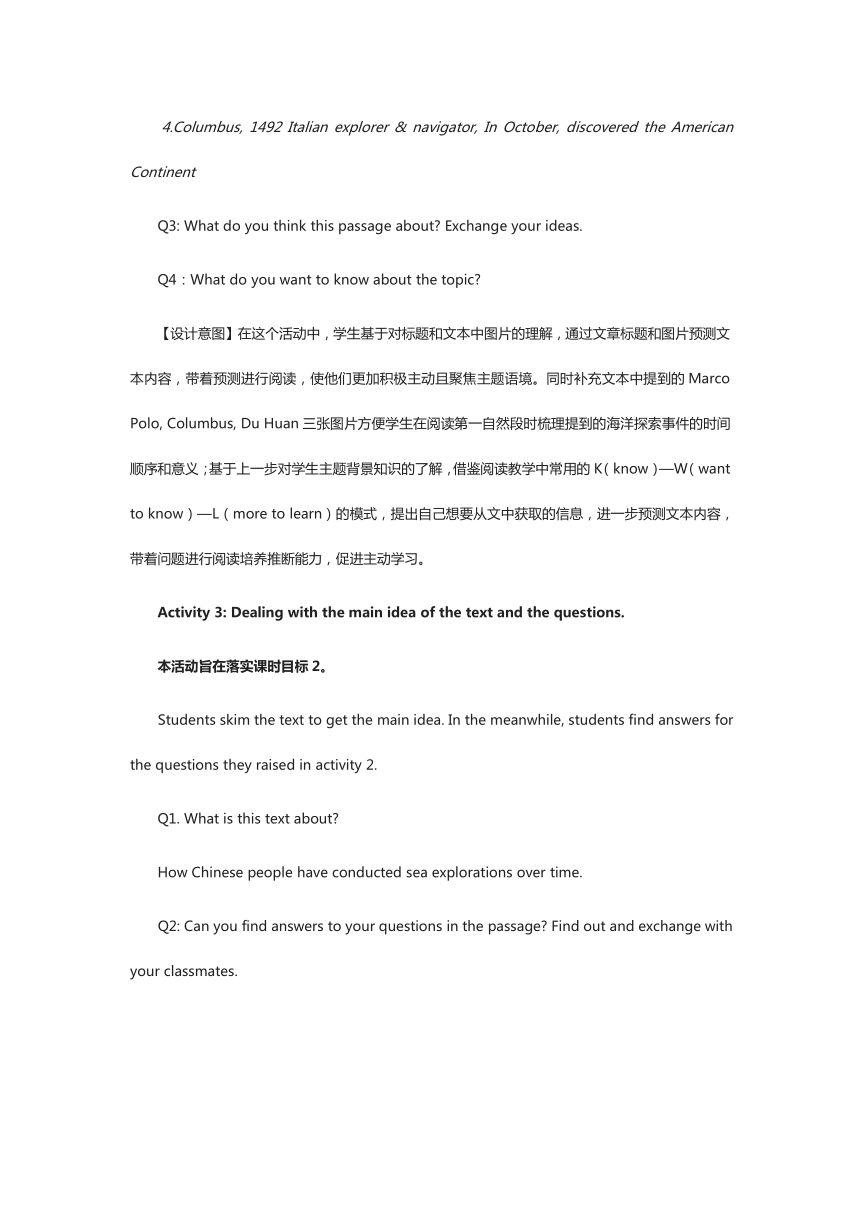
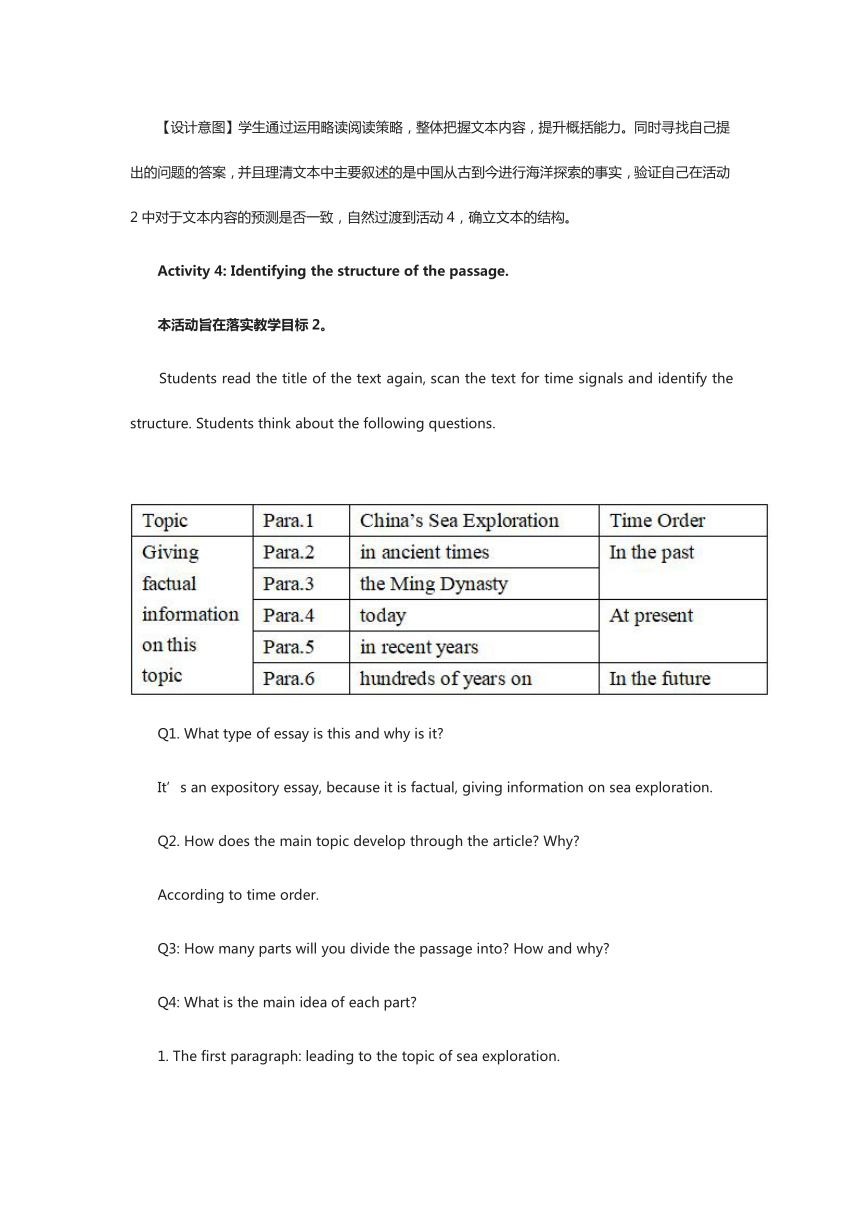
文档简介
Unit 3 REACHING OUT ACROSS THE SEA
Reading and Thinking: Reaching Out Across the Sea
文本简析
本单元阅读文本的话题是中国在海洋探索方面的成就、现状与期待,旨在让学生了解中国提出“一带一路”倡议的现实意义和价值,充分了解人类对海洋探索的原因,帮助学生树立人类命运共同体意识。
文本采用了说明性文体,按照时间顺序说明了中国从古到今在海洋探索方面所做的尝试与取得的成绩,展望了人类为了共同命运携手探索海洋的远景。正文内容按时间顺序逐步进行说明,第一段阐述了贸易和求知欲对人类文明发展的推动作用,简介东方特别是中国在海洋探索上领先于西方的史实;第二、三段介绍了早期的海上丝绸之路和郑和七下西洋的事件及其意义;第四、五段介绍当前我国“一带一路”作为古代丝绸之路的继承和发展的重大意义及中国近年参与海洋探索国际合作的重要意义;第六段以对人类海洋探索的未来的展望结束全文,旨在激发学生对海洋探索的兴趣,树立人类命运共同体意识。
在进行文本教学设计时,要帮助学生梳理关于海洋探索意义类的语言,其中包括有关商业、文化、科研交流等方面的表达。此外,表达时间顺序的语言是本文行文逻辑,也是值得学生关注的标志性语言。本文段落之间的逻辑联系,段落中的主题句位置和段首句、段尾句对行文逻辑的贡献也是需要学生体会并学习的。此外,本课需首要关注的文本内容的思想性,即探索海洋的意义从古代商贸、好奇心到如今人类命运共同体建设的转变,是学生在目前生活的世界中面临的新形势。地球村的人们命运紧密相连,就像新型冠状病毒肆虐,没有哪个国家能独善其身,只有树立命运共同体意识,全球合作,人类才能从容面对挑战,战胜生存危机。
教学设计(共2课时)
第1课时
一、教学内容
理解全文,了解中国古代、现在及将来在海洋探索方面的尝试及意义,厘清说明文本的说明顺序。
二、课时目标
1.围绕海洋主题,自由讨论,并根据标题和图片,进行自主提问,预测文本内容,激活背景知识,准备相关话题语言。
2.通过略读、梳理、归纳等策略,提取文本信息,分析段落中句子间的关系和文本的段落间关系,理清文本叙述的时间顺序和说明文引入话的写作技巧,发展逻辑思维能力。
3.通过文本分析以及问题链,完成各个时间段海洋探索的“benefit”、“problem”、“effects”的内容梳理,深入探究海洋探索的意义,并根据上下文理解相关词语,整理和丰富相关语言,最后通过课文复述巩固所学内容。
三、教学过程
Activity 1: Talking about sea exploration.
本活动旨在落实课时目标1。
Students work in groups of four and discuss the following questions.
Q1: What do you know about the topic List out some events you know about sea exploration.
Q2: What do you think of the purpose of reaching out across the sea Can you think of the problems when ancient people tried to reach out across the sea Why did they still carry out the task
【设计意图】此活动是导入环节。学生就上述两个问题进行小组讨论,激活学生背景知识,引发学生对于话题的深入思考。第一个问题了解学生的背景知识,引出话题词汇sea exploration, across the sea, Zheng He, Marco Polo, Columbus, Magellan 等。通过学生相互交流,激发学生探究这个话题的兴趣,丰富学生的背景知识。第二个问题引发学生对话题的进一步思考,引出trade, exploration, curiosity, cultural exchange等话题语言,为深入研读课文内容以及第二课时探究海洋探索意义作好铺垫。
Activity 2: Predicting the content of the passage.
本活动旨在落实课时目标1。
Students look at the title of the passage and the picture, and then answer the questions.
Q1: What does “reaching out across the sea” mean
Q2: What’s the picture about What about the other three pictures List the events according to time order.
1.Du Huan, 751-762, Soldier &Traveler, to West Asia & North Africa, Record of My Travels
2.Marco Polo, 1275-1295, Italian traveler and businessman, the Silk Road, CHINA
3.Zheng He, 1405-1433,Chinese navigator & diplomat, India Ocean &Africa
4.Columbus, 1492 Italian explorer & navigator, In October, discovered the American Continent
Q3: What do you think this passage about Exchange your ideas.
Q4:What do you want to know about the topic
【设计意图】在这个活动中,学生基于对标题和文本中图片的理解,通过文章标题和图片预测文本内容,带着预测进行阅读,使他们更加积极主动且聚焦主题语境。同时补充文本中提到的Marco Polo, Columbus, Du Huan三张图片方便学生在阅读第一自然段时梳理提到的海洋探索事件的时间顺序和意义;基于上一步对学生主题背景知识的了解,借鉴阅读教学中常用的K(know)—W(want to know)—L(more to learn)的模式,提出自己想要从文中获取的信息,进一步预测文本内容,带着问题进行阅读培养推断能力,促进主动学习。
Activity 3: Dealing with the main idea of the text and the questions.
本活动旨在落实课时目标2。
Students skim the text to get the main idea. In the meanwhile, students find answers for the questions they raised in activity 2.
Q1. What is this text about
How Chinese people have conducted sea explorations over time.
Q2: Can you find answers to your questions in the passage Find out and exchange with your classmates.
【设计意图】学生通过运用略读阅读策略,整体把握文本内容,提升概括能力。同时寻找自己提出的问题的答案,并且理清文本中主要叙述的是中国从古到今进行海洋探索的事实,验证自己在活动2中对于文本内容的预测是否一致,自然过渡到活动4,确立文本的结构。
Activity 4: Identifying the structure of the passage.
本活动旨在落实教学目标2。
Students read the title of the text again, scan the text for time signals and identify the structure. Students think about the following questions.
Q1. What type of essay is this and why is it
It’s an expository essay, because it is factual, giving information on sea exploration.
Q2. How does the main topic develop through the article Why
According to time order.
Q3: How many parts will you divide the passage into How and why
Q4: What is the main idea of each part
1. The first paragraph: leading to the topic of sea exploration.
2. The second and third paragraph: China’s sea explorations in ancient times.
3. The fourth and fifth paragraph: China’s sea explorations at present
4. The sixth paragraph: China’s mission to reach out across the sea in the future.
【设计意图】关注标题中关键词“sea”和主题“sea exploration”, 分辨文章结构类型,了解本篇文章主题内容并厘清文章行文逻辑,从而通过时间标志来划分文章结构,从而了解文章的文体结构——围绕中国海洋探索的话题进行说明,然后关注每个自然段中海洋探索事件的时间,为学生理清文本段落间的关系提供帮助。在此基础上引导学生分段,明确文章的时间顺序,并对四个部分进行概括,推进学生思维层次。
Activity 5: Focusing on the introduction to the topic
本活动旨在落实课时目标2。
Read Paragraph 1 and answer the following questions.
Q1: What is the topic sentence of the first paragraph
The first sentence: Curiosity and trade have often formed the foundation of mankind’s greatest achievements.
Q2. Why are “completing the world map”, Marco Polo and Columbus mentioned
They are mentioned as examples to demonstrate that “trade and curiosity have often formed the foundation of mankind's greatest achievements”.
Q3: Why is “however” used in the last sentence What is the function of the last sentence
“However” is usually used to introduce an important idea that is somehow contrary to something that has been said previously. In this case, it is to lead a transitional sentence directing the discussion from ocean exploration in general to expeditions made by people of the East, in particularly, by China, thus entering the main topic of the article.
【设计意图】进入文章主题,关注第一自然段句子之间的关系,思考最后一句中“however”的作用以及最后一句所起的作用,引导学生思考和学习作者切入主题的方式和过程:一般性观点——举例支撑——用“however”将一般性讨论导向专题讨论(进入主题)。这同时为学生后面自主问答提供方向及范例。
Activity 6: Focusing on the information of China’s sea exploration over time.
本活动旨在落实教学目标3。
Students read Paragraphs 2-6 carefully, write down questions you may have while reading. Exchange the questions in groups and try to find out answers together. Then mark the sea route of China’s sea exploration in different times on the maps given, and try to find out the language relating to the significance of China’s reaching out across the sea.
While checking the answers, students answer the following questions:
Q1: Note the changes in the significances over time, what conclusions can we draw from them About the question asked at the beginning of the class what is the purpose for people to reach out across the sea, do you have different ideas now
1) Trade and curiosity have been constant motivations behind China’s reaching out across the sea
2) In ancient times, cultural exchanges and developing relations/friendships were, instead of a conscious pursuit, mostly by-products of self-interested trade and curiosity.
3) Today, while trade and curiosity remain motivations of China’s sea explorations, we are consciously pursuing cooperation, bonds, development of the whole area and benefits for mankind as a whole. Also note that the changes in purposes/significances reflect the progress of human mind over time, but also demonstrate the fact that China is much stronger today than ever before so that we can be much more involved in international affairs and shoulder much greater responsibility for mankind.
Q2. What language difficulties do you meet with while reading
【设计意图】明确主题后,学生再次自主阅读文本,提出问题相互帮助解决,在此基础上梳理信息完成表格。学生需要梳理内容并进行提炼和概括,围绕文章的两个逻辑层次展开:(1) 从过去到现在到将来: ancient Maritime Silk Road → Zheng He → the 21st Maritime Silk Road → China’s drive to reach out across the sea far into the future,通过在地图上标出不同时期中国海洋探索经过的区域可以帮助学生进一步深入理解海上探索的发展历程; (2)海洋探索的意义从贸易到科研:from expeditions for trading goods and making awareness of other cultures, to international cooperation and scientific researches for the shared future of mankind,逐步递进,深入理解国家强大以后作为大国在国家上的担当,帮助学生深层理解“一带一路”倡议的重要意义。特别注意这两个逻辑层的相互交织和关联,理解它们如何共同呈现文章的主题。在此基础上,梳理段落间句子之间的关系及段落之间的关系,让学生体会这篇说明文的写作技巧。
Assignment: Retelling China’s sea exploration according to the table.
本活动旨在落实课时教学目标3。
Retell the passage about China’s sea exploration over time and think about the problems for reaching out across the sea.
Students are supposed to pay attention to the structure and use the words and expressions in the passage.
【设计意图】学生运用所学语言内容,结合表格中提取的重要信息,整合结构、内容和语言,对文本进行复述,一方面巩固文章内容,强化主题语言,另一方面思考中国海洋探索中的困难也将成为第二课时的导入。
第2课时
一、教学内容
品读语言,对比中国海洋探索的过去与今天,加深理解海洋探索的意义从贸易、交流到为人类命运共同体的科研合作的层层推进,迁移所学,完成续写任务。
二、课时目标
1.通过品读语言,深入理解文本,概括海洋探索及中国海洋探索的发展历程,培养学生运用所学语言有逻辑顺序进行复述的能力。
2.结合所学,深入探索主题,对比中国过去与今天的海洋探索情况,探讨人类进行海洋探索的意义、代价和影响,发掘和理解语篇所承载的深层次内涵,培养深入思考、探究式学习和批判性思维能力,培养学生的人类命运共同体意识。
3.细品语言,进一步理清段落中句子间的关系和段落间关系,培养学生逻辑思维能力和布局谋篇能力;通过展望中国海洋探索的远景,培养学生想象能力和分析问题能力,发展学生创造性思维和批判性思维,同时运用所学写作技巧和话题语言续写来表达自己的思想。
三、教学过程
Activity 1: Retelling China’s sea exploration according to the table.
本活动为实现课时教学目标1作铺垫。
Retell China’s sea exploration over time according to the table finished in the last period.
Students are supposed to pay attention to the verb phrases of showing the significance of sea exploration.
【设计意图】此活动是热身环节,作为第一课时作业的展示,学生需要整合运用语言、内容与结构进行简单复述,一方面可以回顾文章主要内容,复现目标词汇,巩固主线和结构意识,另一方面也自然过渡到本节课的阅读重点——品读语言,对比中国古代与现代海洋探索的事迹和意义,从而体会人类进入命运共同体时代共同合作面对生存挑战的意义。
Activity 2: Discussing about the problems and effects of China’s sea exploration
本活动旨在落实课时目标2。
Answer the questions after discussion in groups.
Q1. Why does China revisit the ancient sea routes travelled by Zheng He
Encourage cooperation and trade, strengthen bonds, and help develop the whole area, for the benefit of future trade and culture exchange.
Q2. Why do you think China continued to explore the sea despite all the problems What’s the effects on the world
Despite all the problems, China continues to explore the sea for the benefit of all humans.
Effects on the world: cooperate and communicate with the world.
【设计意图】紧接着复述任务后,教师引导学生重回课本,深入思考,探索中国从古到今海洋探索中的好处、困难和影响,引导学生深入思考中国进行海洋探索的意义,培养学生人类命运共同体意识。
Activity 3: Summarizing the writing technique.
本活动旨在落实课时目标3。
Students discuss in groups and summarize the writing technique.
Q1: What is the function of the first sentence in 2nd paragraph
It serves as a transitional sentence, guide the readers from the known facts to the unknown facts, from the Silk Road overland to the Maritime Silk Road, the subject given.
Q2. What is the function of the first sentence in 3rd paragraph
It connects the second paragraph, continuing the subject, the development of ancient Maritime Silk Road and also severs as the topic sentence of third paragraph.
Q3. What is the function of the first sentence in 4th paragraph
A transitional sentence making a turn of the discussion from ancient times to the current. Note the writing technique: one simple sentence makes a transition crossing hundreds of years.
Q4. What is the function of the first sentence in the 5th paragraph
To serve as a transitional sentence expanding the topic to include sea explorations beyond trade and cultural exchange.
Q5.How is para.6 related to the previous ones
It follows the previous discussion of sea explorations in the past and the present, and further pushes it to sea explorations in the future.
Q6: How are the sentences connected in each paragraph And how are paragraphs connected
Looking back on the first paragraph, then summarize the writing skill used in the expository essay: The text has four parts, and each part is a layer of meaning: topic introduction, the past, the present, and the future. So there is a clear line of time order running through the article and the first sentence is extremely important when giving information on a subject, leading the topic to the point the author wants to stress.
Note the words and sentences the author uses to make transition from one layer to another. It is an important writing skill to learn.
【设计意图】学生再次回顾文本,重新梳理信息,分析2、3、4、5每个自然段第一句的作用,通过讨论并回顾第一自然段首尾句的作用,然后自然过渡到对写作技巧的探索,培养学生逻辑思维能力和谋篇布局的意识。
Activity 4: Looking forward to the future of China’s sea exploration.
本活动旨在落实课时目标3。
Students exchange idea in groups.
Q1: Do you have any other questions about this topic Share your questions in groups and try to get possible answers.
Q2: What do you think of the future of China’s sea exploration
Q3: Imagine that you are a scientist coming from 2100 and you are giving a speech on the topic of China’s sea exploration of 22nd Century. Your speech will cover the following aspects in the table and try to use some transitional sentences, making your speech smooth and concise.
【设计意图】此活动为半开放性的活动,呼应第一课时导入的问题,学生通过对前面中国海洋探索事件的学习,进一步回顾自己读前问题, 在小组分析问题并试图获得回应,培养探究意识和合作精神。学生根据课本所学以及合理想象,通过分享中国海洋探索的远景,激发学生创造性思维,学会使用写作技巧和所学话题语言得体表达自己的思想和观点。
Activity 5: Talking about your own idea.
本活动旨在落实课时目标3。
Think about the following questions and talk about your own attitude in pairs.
Q1: As for this topic,what impresses you the most in the passage
Q2: What do you think of the future of China’s further exploration in sea Are you in favor of the further exploration?Why or why not
【设计意图】该活动是一个完全开放性的活动,每个学生都会有不同的答案。运用迁移所学,自由口头表达自己对海洋探索的态度。对于中国海洋探索的未来,每个人的想法是不一样的,有乐观,有担忧,有认为值得投入,也有认为不值得付出太大代价,这里给学生自由表达的空间只要学会有支撑自己观点的事实就可以了,进一步培养学生批判性思维和正确的价值观。
Assignment:
此任务旨在迁移一、二课时所学,培养学生辩证分析问题的能力。
Write about your idea of the future of China’s sea exploration. And add your attitude towards the effort China have made in sea exploration. You’re expected to use the language and the writing technique learnt in the passage.
1.Surf the internet to get more information about the topic of China’s sea exploration.
【设计意图】通过活动4和活动5的铺垫,结合所学,续写自己想象的中国海洋探索的未来发展。在完成任务的过程中,能较多地使用已学语言、内容、结构和写作手法来描述自己对海洋探索的真实观点,培养学生的思维能力和表达能力。另一项作业为让学生课后上网搜寻更多有关海洋探索的资料,是课堂内容的适度延伸,既能帮助他们更好巩固所学知识,又能培养自主学习意识,拓宽阅读视野。
Reading and Thinking: Reaching Out Across the Sea
文本简析
本单元阅读文本的话题是中国在海洋探索方面的成就、现状与期待,旨在让学生了解中国提出“一带一路”倡议的现实意义和价值,充分了解人类对海洋探索的原因,帮助学生树立人类命运共同体意识。
文本采用了说明性文体,按照时间顺序说明了中国从古到今在海洋探索方面所做的尝试与取得的成绩,展望了人类为了共同命运携手探索海洋的远景。正文内容按时间顺序逐步进行说明,第一段阐述了贸易和求知欲对人类文明发展的推动作用,简介东方特别是中国在海洋探索上领先于西方的史实;第二、三段介绍了早期的海上丝绸之路和郑和七下西洋的事件及其意义;第四、五段介绍当前我国“一带一路”作为古代丝绸之路的继承和发展的重大意义及中国近年参与海洋探索国际合作的重要意义;第六段以对人类海洋探索的未来的展望结束全文,旨在激发学生对海洋探索的兴趣,树立人类命运共同体意识。
在进行文本教学设计时,要帮助学生梳理关于海洋探索意义类的语言,其中包括有关商业、文化、科研交流等方面的表达。此外,表达时间顺序的语言是本文行文逻辑,也是值得学生关注的标志性语言。本文段落之间的逻辑联系,段落中的主题句位置和段首句、段尾句对行文逻辑的贡献也是需要学生体会并学习的。此外,本课需首要关注的文本内容的思想性,即探索海洋的意义从古代商贸、好奇心到如今人类命运共同体建设的转变,是学生在目前生活的世界中面临的新形势。地球村的人们命运紧密相连,就像新型冠状病毒肆虐,没有哪个国家能独善其身,只有树立命运共同体意识,全球合作,人类才能从容面对挑战,战胜生存危机。
教学设计(共2课时)
第1课时
一、教学内容
理解全文,了解中国古代、现在及将来在海洋探索方面的尝试及意义,厘清说明文本的说明顺序。
二、课时目标
1.围绕海洋主题,自由讨论,并根据标题和图片,进行自主提问,预测文本内容,激活背景知识,准备相关话题语言。
2.通过略读、梳理、归纳等策略,提取文本信息,分析段落中句子间的关系和文本的段落间关系,理清文本叙述的时间顺序和说明文引入话的写作技巧,发展逻辑思维能力。
3.通过文本分析以及问题链,完成各个时间段海洋探索的“benefit”、“problem”、“effects”的内容梳理,深入探究海洋探索的意义,并根据上下文理解相关词语,整理和丰富相关语言,最后通过课文复述巩固所学内容。
三、教学过程
Activity 1: Talking about sea exploration.
本活动旨在落实课时目标1。
Students work in groups of four and discuss the following questions.
Q1: What do you know about the topic List out some events you know about sea exploration.
Q2: What do you think of the purpose of reaching out across the sea Can you think of the problems when ancient people tried to reach out across the sea Why did they still carry out the task
【设计意图】此活动是导入环节。学生就上述两个问题进行小组讨论,激活学生背景知识,引发学生对于话题的深入思考。第一个问题了解学生的背景知识,引出话题词汇sea exploration, across the sea, Zheng He, Marco Polo, Columbus, Magellan 等。通过学生相互交流,激发学生探究这个话题的兴趣,丰富学生的背景知识。第二个问题引发学生对话题的进一步思考,引出trade, exploration, curiosity, cultural exchange等话题语言,为深入研读课文内容以及第二课时探究海洋探索意义作好铺垫。
Activity 2: Predicting the content of the passage.
本活动旨在落实课时目标1。
Students look at the title of the passage and the picture, and then answer the questions.
Q1: What does “reaching out across the sea” mean
Q2: What’s the picture about What about the other three pictures List the events according to time order.
1.Du Huan, 751-762, Soldier &Traveler, to West Asia & North Africa, Record of My Travels
2.Marco Polo, 1275-1295, Italian traveler and businessman, the Silk Road, CHINA
3.Zheng He, 1405-1433,Chinese navigator & diplomat, India Ocean &Africa
4.Columbus, 1492 Italian explorer & navigator, In October, discovered the American Continent
Q3: What do you think this passage about Exchange your ideas.
Q4:What do you want to know about the topic
【设计意图】在这个活动中,学生基于对标题和文本中图片的理解,通过文章标题和图片预测文本内容,带着预测进行阅读,使他们更加积极主动且聚焦主题语境。同时补充文本中提到的Marco Polo, Columbus, Du Huan三张图片方便学生在阅读第一自然段时梳理提到的海洋探索事件的时间顺序和意义;基于上一步对学生主题背景知识的了解,借鉴阅读教学中常用的K(know)—W(want to know)—L(more to learn)的模式,提出自己想要从文中获取的信息,进一步预测文本内容,带着问题进行阅读培养推断能力,促进主动学习。
Activity 3: Dealing with the main idea of the text and the questions.
本活动旨在落实课时目标2。
Students skim the text to get the main idea. In the meanwhile, students find answers for the questions they raised in activity 2.
Q1. What is this text about
How Chinese people have conducted sea explorations over time.
Q2: Can you find answers to your questions in the passage Find out and exchange with your classmates.
【设计意图】学生通过运用略读阅读策略,整体把握文本内容,提升概括能力。同时寻找自己提出的问题的答案,并且理清文本中主要叙述的是中国从古到今进行海洋探索的事实,验证自己在活动2中对于文本内容的预测是否一致,自然过渡到活动4,确立文本的结构。
Activity 4: Identifying the structure of the passage.
本活动旨在落实教学目标2。
Students read the title of the text again, scan the text for time signals and identify the structure. Students think about the following questions.
Q1. What type of essay is this and why is it
It’s an expository essay, because it is factual, giving information on sea exploration.
Q2. How does the main topic develop through the article Why
According to time order.
Q3: How many parts will you divide the passage into How and why
Q4: What is the main idea of each part
1. The first paragraph: leading to the topic of sea exploration.
2. The second and third paragraph: China’s sea explorations in ancient times.
3. The fourth and fifth paragraph: China’s sea explorations at present
4. The sixth paragraph: China’s mission to reach out across the sea in the future.
【设计意图】关注标题中关键词“sea”和主题“sea exploration”, 分辨文章结构类型,了解本篇文章主题内容并厘清文章行文逻辑,从而通过时间标志来划分文章结构,从而了解文章的文体结构——围绕中国海洋探索的话题进行说明,然后关注每个自然段中海洋探索事件的时间,为学生理清文本段落间的关系提供帮助。在此基础上引导学生分段,明确文章的时间顺序,并对四个部分进行概括,推进学生思维层次。
Activity 5: Focusing on the introduction to the topic
本活动旨在落实课时目标2。
Read Paragraph 1 and answer the following questions.
Q1: What is the topic sentence of the first paragraph
The first sentence: Curiosity and trade have often formed the foundation of mankind’s greatest achievements.
Q2. Why are “completing the world map”, Marco Polo and Columbus mentioned
They are mentioned as examples to demonstrate that “trade and curiosity have often formed the foundation of mankind's greatest achievements”.
Q3: Why is “however” used in the last sentence What is the function of the last sentence
“However” is usually used to introduce an important idea that is somehow contrary to something that has been said previously. In this case, it is to lead a transitional sentence directing the discussion from ocean exploration in general to expeditions made by people of the East, in particularly, by China, thus entering the main topic of the article.
【设计意图】进入文章主题,关注第一自然段句子之间的关系,思考最后一句中“however”的作用以及最后一句所起的作用,引导学生思考和学习作者切入主题的方式和过程:一般性观点——举例支撑——用“however”将一般性讨论导向专题讨论(进入主题)。这同时为学生后面自主问答提供方向及范例。
Activity 6: Focusing on the information of China’s sea exploration over time.
本活动旨在落实教学目标3。
Students read Paragraphs 2-6 carefully, write down questions you may have while reading. Exchange the questions in groups and try to find out answers together. Then mark the sea route of China’s sea exploration in different times on the maps given, and try to find out the language relating to the significance of China’s reaching out across the sea.
While checking the answers, students answer the following questions:
Q1: Note the changes in the significances over time, what conclusions can we draw from them About the question asked at the beginning of the class what is the purpose for people to reach out across the sea, do you have different ideas now
1) Trade and curiosity have been constant motivations behind China’s reaching out across the sea
2) In ancient times, cultural exchanges and developing relations/friendships were, instead of a conscious pursuit, mostly by-products of self-interested trade and curiosity.
3) Today, while trade and curiosity remain motivations of China’s sea explorations, we are consciously pursuing cooperation, bonds, development of the whole area and benefits for mankind as a whole. Also note that the changes in purposes/significances reflect the progress of human mind over time, but also demonstrate the fact that China is much stronger today than ever before so that we can be much more involved in international affairs and shoulder much greater responsibility for mankind.
Q2. What language difficulties do you meet with while reading
【设计意图】明确主题后,学生再次自主阅读文本,提出问题相互帮助解决,在此基础上梳理信息完成表格。学生需要梳理内容并进行提炼和概括,围绕文章的两个逻辑层次展开:(1) 从过去到现在到将来: ancient Maritime Silk Road → Zheng He → the 21st Maritime Silk Road → China’s drive to reach out across the sea far into the future,通过在地图上标出不同时期中国海洋探索经过的区域可以帮助学生进一步深入理解海上探索的发展历程; (2)海洋探索的意义从贸易到科研:from expeditions for trading goods and making awareness of other cultures, to international cooperation and scientific researches for the shared future of mankind,逐步递进,深入理解国家强大以后作为大国在国家上的担当,帮助学生深层理解“一带一路”倡议的重要意义。特别注意这两个逻辑层的相互交织和关联,理解它们如何共同呈现文章的主题。在此基础上,梳理段落间句子之间的关系及段落之间的关系,让学生体会这篇说明文的写作技巧。
Assignment: Retelling China’s sea exploration according to the table.
本活动旨在落实课时教学目标3。
Retell the passage about China’s sea exploration over time and think about the problems for reaching out across the sea.
Students are supposed to pay attention to the structure and use the words and expressions in the passage.
【设计意图】学生运用所学语言内容,结合表格中提取的重要信息,整合结构、内容和语言,对文本进行复述,一方面巩固文章内容,强化主题语言,另一方面思考中国海洋探索中的困难也将成为第二课时的导入。
第2课时
一、教学内容
品读语言,对比中国海洋探索的过去与今天,加深理解海洋探索的意义从贸易、交流到为人类命运共同体的科研合作的层层推进,迁移所学,完成续写任务。
二、课时目标
1.通过品读语言,深入理解文本,概括海洋探索及中国海洋探索的发展历程,培养学生运用所学语言有逻辑顺序进行复述的能力。
2.结合所学,深入探索主题,对比中国过去与今天的海洋探索情况,探讨人类进行海洋探索的意义、代价和影响,发掘和理解语篇所承载的深层次内涵,培养深入思考、探究式学习和批判性思维能力,培养学生的人类命运共同体意识。
3.细品语言,进一步理清段落中句子间的关系和段落间关系,培养学生逻辑思维能力和布局谋篇能力;通过展望中国海洋探索的远景,培养学生想象能力和分析问题能力,发展学生创造性思维和批判性思维,同时运用所学写作技巧和话题语言续写来表达自己的思想。
三、教学过程
Activity 1: Retelling China’s sea exploration according to the table.
本活动为实现课时教学目标1作铺垫。
Retell China’s sea exploration over time according to the table finished in the last period.
Students are supposed to pay attention to the verb phrases of showing the significance of sea exploration.
【设计意图】此活动是热身环节,作为第一课时作业的展示,学生需要整合运用语言、内容与结构进行简单复述,一方面可以回顾文章主要内容,复现目标词汇,巩固主线和结构意识,另一方面也自然过渡到本节课的阅读重点——品读语言,对比中国古代与现代海洋探索的事迹和意义,从而体会人类进入命运共同体时代共同合作面对生存挑战的意义。
Activity 2: Discussing about the problems and effects of China’s sea exploration
本活动旨在落实课时目标2。
Answer the questions after discussion in groups.
Q1. Why does China revisit the ancient sea routes travelled by Zheng He
Encourage cooperation and trade, strengthen bonds, and help develop the whole area, for the benefit of future trade and culture exchange.
Q2. Why do you think China continued to explore the sea despite all the problems What’s the effects on the world
Despite all the problems, China continues to explore the sea for the benefit of all humans.
Effects on the world: cooperate and communicate with the world.
【设计意图】紧接着复述任务后,教师引导学生重回课本,深入思考,探索中国从古到今海洋探索中的好处、困难和影响,引导学生深入思考中国进行海洋探索的意义,培养学生人类命运共同体意识。
Activity 3: Summarizing the writing technique.
本活动旨在落实课时目标3。
Students discuss in groups and summarize the writing technique.
Q1: What is the function of the first sentence in 2nd paragraph
It serves as a transitional sentence, guide the readers from the known facts to the unknown facts, from the Silk Road overland to the Maritime Silk Road, the subject given.
Q2. What is the function of the first sentence in 3rd paragraph
It connects the second paragraph, continuing the subject, the development of ancient Maritime Silk Road and also severs as the topic sentence of third paragraph.
Q3. What is the function of the first sentence in 4th paragraph
A transitional sentence making a turn of the discussion from ancient times to the current. Note the writing technique: one simple sentence makes a transition crossing hundreds of years.
Q4. What is the function of the first sentence in the 5th paragraph
To serve as a transitional sentence expanding the topic to include sea explorations beyond trade and cultural exchange.
Q5.How is para.6 related to the previous ones
It follows the previous discussion of sea explorations in the past and the present, and further pushes it to sea explorations in the future.
Q6: How are the sentences connected in each paragraph And how are paragraphs connected
Looking back on the first paragraph, then summarize the writing skill used in the expository essay: The text has four parts, and each part is a layer of meaning: topic introduction, the past, the present, and the future. So there is a clear line of time order running through the article and the first sentence is extremely important when giving information on a subject, leading the topic to the point the author wants to stress.
Note the words and sentences the author uses to make transition from one layer to another. It is an important writing skill to learn.
【设计意图】学生再次回顾文本,重新梳理信息,分析2、3、4、5每个自然段第一句的作用,通过讨论并回顾第一自然段首尾句的作用,然后自然过渡到对写作技巧的探索,培养学生逻辑思维能力和谋篇布局的意识。
Activity 4: Looking forward to the future of China’s sea exploration.
本活动旨在落实课时目标3。
Students exchange idea in groups.
Q1: Do you have any other questions about this topic Share your questions in groups and try to get possible answers.
Q2: What do you think of the future of China’s sea exploration
Q3: Imagine that you are a scientist coming from 2100 and you are giving a speech on the topic of China’s sea exploration of 22nd Century. Your speech will cover the following aspects in the table and try to use some transitional sentences, making your speech smooth and concise.
【设计意图】此活动为半开放性的活动,呼应第一课时导入的问题,学生通过对前面中国海洋探索事件的学习,进一步回顾自己读前问题, 在小组分析问题并试图获得回应,培养探究意识和合作精神。学生根据课本所学以及合理想象,通过分享中国海洋探索的远景,激发学生创造性思维,学会使用写作技巧和所学话题语言得体表达自己的思想和观点。
Activity 5: Talking about your own idea.
本活动旨在落实课时目标3。
Think about the following questions and talk about your own attitude in pairs.
Q1: As for this topic,what impresses you the most in the passage
Q2: What do you think of the future of China’s further exploration in sea Are you in favor of the further exploration?Why or why not
【设计意图】该活动是一个完全开放性的活动,每个学生都会有不同的答案。运用迁移所学,自由口头表达自己对海洋探索的态度。对于中国海洋探索的未来,每个人的想法是不一样的,有乐观,有担忧,有认为值得投入,也有认为不值得付出太大代价,这里给学生自由表达的空间只要学会有支撑自己观点的事实就可以了,进一步培养学生批判性思维和正确的价值观。
Assignment:
此任务旨在迁移一、二课时所学,培养学生辩证分析问题的能力。
Write about your idea of the future of China’s sea exploration. And add your attitude towards the effort China have made in sea exploration. You’re expected to use the language and the writing technique learnt in the passage.
1.Surf the internet to get more information about the topic of China’s sea exploration.
【设计意图】通过活动4和活动5的铺垫,结合所学,续写自己想象的中国海洋探索的未来发展。在完成任务的过程中,能较多地使用已学语言、内容、结构和写作手法来描述自己对海洋探索的真实观点,培养学生的思维能力和表达能力。另一项作业为让学生课后上网搜寻更多有关海洋探索的资料,是课堂内容的适度延伸,既能帮助他们更好巩固所学知识,又能培养自主学习意识,拓宽阅读视野。
